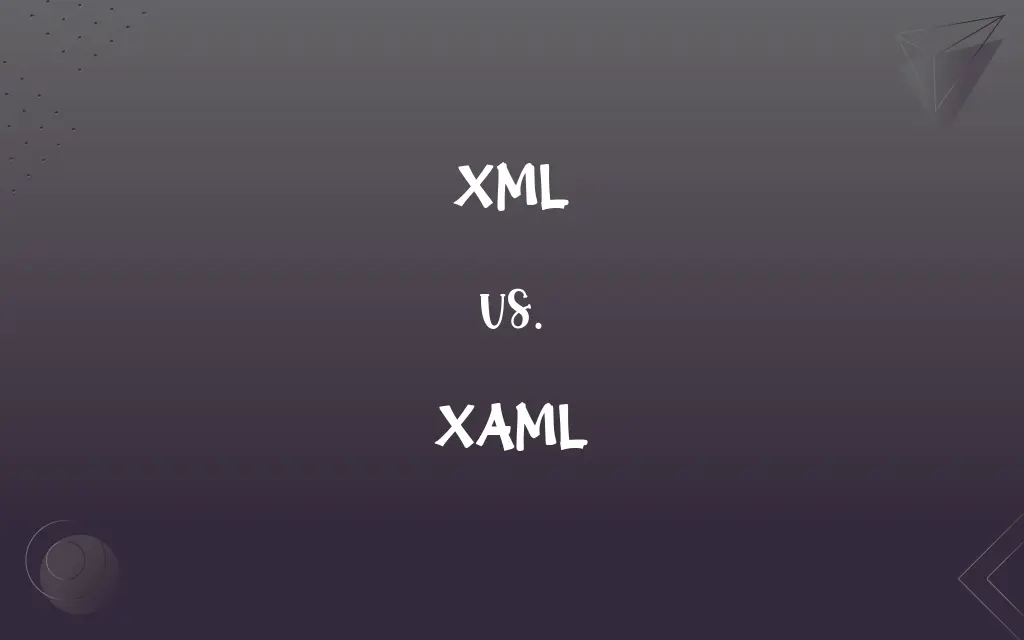XML vs. XAML: What's the Difference?
Edited by Aimie Carlson || By Harlon Moss || Published on February 17, 2024
XML is a flexible markup language for data structuring and exchange, while XAML, based on XML, is specifically designed for defining user interfaces in .NET applications.

Key Differences
XML (Extensible Markup Language) is a widely-used format for structuring, storing, and transporting data, known for its simplicity and flexibility. XAML (Extensible Application Markup Language) is a specific application of XML, developed by Microsoft, for defining user interfaces in .NET framework applications.
XML is designed to be both human- and machine-readable, making it ideal for a wide range of applications, from web development to configuration files. XAML, while also human- and machine-readable, is specifically tailored for creating and initializing .NET objects with a hierarchical structure, particularly for GUI elements.
In XML, custom tags can be defined to suit the needs of various data representation, without any predefined tag set. XAML, on the other hand, uses a predefined set of tags that correspond to .NET objects, making it suitable for direct representation of user interface components in applications.
XML is platform- and language-independent, used in many programming environments and for various purposes like web services (SOAP) and RSS feeds. XAML is primarily used in the context of .NET framework and its technologies, such as WPF (Windows Presentation Foundation) and UWP (Universal Windows Platform), for GUI design.
The syntax of XML is straightforward and consists of elements with start and end tags. XAML extends this syntax with additional features like property element syntax and attached properties, which are particularly useful in defining user interface elements and their behaviors.
ADVERTISEMENT
Comparison Chart
Purpose
Data structuring and exchange in various domains
Defining user interfaces in .NET applications
Flexibility
Highly flexible, custom tags can be created
Uses predefined tags corresponding to .NET objects
Usage Environment
Platform and language-independent
Primarily used with .NET technologies
Syntax
Standard XML syntax, simple and universal
Extended XML syntax with additional features for GUI
Primary Application
Web services, data storage, configuration files
GUI design in WPF, UWP, and other .NET frameworks
ADVERTISEMENT
XML and XAML Definitions
XML
XML allows users to define their own tags.
The XML document included custom tags to describe each product in the catalog.
XAML
XAML simplifies complex UI design in software development.
The software's intricate interface was efficiently created using XAML.
XML
XML is platform-independent and well-suited for data storage and configuration.
The application's settings are stored in an XML configuration file.
XAML
XAML allows the definition of UI elements in a declarative manner.
He used XAML to define the layout and style of the buttons in the application.
XML
XML is a markup language used for encoding documents in a format that is both human and machine-readable.
The company stores its data in XML files for easy data exchange between systems.
XAML
XAML is a markup language for creating user interfaces in .NET applications.
The developer designed the application's UI using XAML in a WPF project.
XML
XML is widely used in web technologies for data transmission.
The web service communicates using XML to send and receive data.
XAML
XAML integrates seamlessly with .NET framework objects.
XAML is used to instantiate and initialize .NET framework objects in the GUI.
XML
XML forms the basis for many web standards, including XHTML and RSS.
The news website uses an RSS feed, which is based on XML, to publish its latest stories.
XAML
XAML supports advanced UI features like data binding and event handling.
The XAML file included data binding expressions for dynamic content display.
XML
An international standard metalanguage for creating markup languages that structure digital information in a way that allows for the exchange, display, and storage of data independent of proprietary operating systems and hardware devices.
FAQs
What does XML stand for?
XML stands for Extensible Markup Language.
What is the primary use of XML?
XML is used for structuring, storing, and exchanging data across different systems.
Can XAML be used without .NET?
XAML is closely tied to the .NET framework and is not typically used outside of it.
Is XML similar to HTML?
While both are markup languages, XML is primarily for data representation, unlike HTML which is for web page structure.
What does XAML stand for?
XAML stands for Extensible Application Markup Language.
Can XML be used for web development?
Yes, XML can be used in web development, particularly for data exchange.
Is XAML only for Windows applications?
XAML is primarily used in Windows applications, especially within the .NET framework.
How is XAML different from HTML?
XAML is used for desktop application UIs in .NET, while HTML is for structuring web pages.
What are XML schemas?
XML schemas define the structure and rules for an XML document.
How does XAML handle event handling?
XAML supports event handling through its integration with .NET objects and code-behind files.
Can XML handle multimedia data?
XML can reference multimedia data but doesn't store it directly.
Is XML a programming language?
No, XML is a markup language, not a programming language.
What is XAML mainly used for?
XAML is mainly used for defining user interfaces in .NET framework applications.
Does XAML support animations?
Yes, XAML supports animations, especially in WPF and UWP applications.
What is data binding in XAML?
Data binding in XAML is linking UI elements to data sources for dynamic content display.
Does XML support namespaces?
Yes, XML supports namespaces to avoid element name conflicts.
What are the benefits of using XAML in application development?
XAML simplifies UI design, enhances readability, and improves maintainability in application development.
Is XML case-sensitive?
Yes, XML is case-sensitive, meaning tag names must consistently maintain case.
Can XAML be compiled?
XAML can be compiled into .NET assemblies for improved performance.
Can XAML be used for mobile app development?
XAML is used in Xamarin.Forms for cross-platform mobile app development.
About Author
Written by
Harlon MossHarlon is a seasoned quality moderator and accomplished content writer for Difference Wiki. An alumnus of the prestigious University of California, he earned his degree in Computer Science. Leveraging his academic background, Harlon brings a meticulous and informed perspective to his work, ensuring content accuracy and excellence.
Edited by
Aimie CarlsonAimie Carlson, holding a master's degree in English literature, is a fervent English language enthusiast. She lends her writing talents to Difference Wiki, a prominent website that specializes in comparisons, offering readers insightful analyses that both captivate and inform.































































